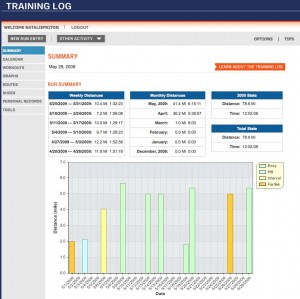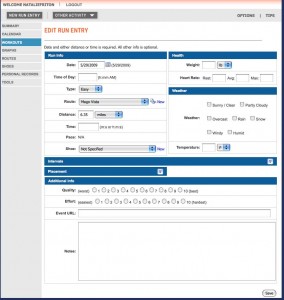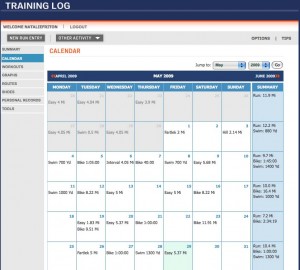 For the last month I have been using the training log on runnersworld.com both to log my work-outs as well as to experiment with one of the many available online training log programs available to athletes. It was a few months ago that I decided I would use and review as many logs as possible and I had started with the log on Race Nation‘s website before moving on to the Runner’s World log.
For the last month I have been using the training log on runnersworld.com both to log my work-outs as well as to experiment with one of the many available online training log programs available to athletes. It was a few months ago that I decided I would use and review as many logs as possible and I had started with the log on Race Nation‘s website before moving on to the Runner’s World log.
When I started with the RW log, I was slowly building my running routine back up from my marathon recovery and have since begun training for my first triathlon, so I have multiple kinds of work-outs that I need to track. I already had a profile on rw.com, but if I hadn’t, that would have been the first step, just like for any other site that stores your personal information.
The RW log has one button to enter a new run and another button that drops down with options to enter a bike, swim, strength session, walk, health note, or generic ‘other’ work-out. I found entering the first few entries to be tricky because not all fields of the log format were super intuitive to me. For most type of work-outs, standard data fields are: date, time, heart rate (rest, average, and max), route, distance, time, weight, and environment. There is also a standard notes box at the end, which I love, as well as the option to rate the quality and effort of the work-out on a scale of 1 to 10 with 10 being the best or hardest. And, as you may know, I am a big fan of measuring the quality of my work-outs.
Data Entry
I appreciate the detailed amount of information that you can enter into the RW log, however, the process of doing so was not always obvious or user-friendly. For my strength sessions, I wanted to enter the different types of arm, leg, or ab work-outs I had done as well as the sets, repetitions, and weights used and the log has a place to enter all this data. However, it took me several tries to figure out how to actually enter a work-out; turns out you have to hit the plus sign in the “action” column in order for the work-out to be added and then you enter the next move. It wasn’t hard, but it also wasn’t intuitive. Having the ability to enter a specific number of reps and all the related information is fantastic and the log does store the information, so once you’ve entered “biceps lunge” as an exercise, you can always select it again.
 For running, biking, and swimming entries, you have the option of entering a route. The first time I entered a run, I entered all of the details about the run and then went to enter the route. I had to select ‘new route’ which took me away from my log entry to a new page with a map that to me is a cross between mapmyrun.com and MapQuest. Like mapmyrun.com you can click on the map to create a route, however, the size of the map is fixed and very small. As soon as one point on the map is placed, the pin icon designating that point covers up so much of the small map that I find it hard to accurately enter a route. You also can’t enter a starting address, just the city and state, so unless you know exactly where you’re located, it could take a while of zooming in and out of street names to find your exact location.
For running, biking, and swimming entries, you have the option of entering a route. The first time I entered a run, I entered all of the details about the run and then went to enter the route. I had to select ‘new route’ which took me away from my log entry to a new page with a map that to me is a cross between mapmyrun.com and MapQuest. Like mapmyrun.com you can click on the map to create a route, however, the size of the map is fixed and very small. As soon as one point on the map is placed, the pin icon designating that point covers up so much of the small map that I find it hard to accurately enter a route. You also can’t enter a starting address, just the city and state, so unless you know exactly where you’re located, it could take a while of zooming in and out of street names to find your exact location.
When I finally got my first route mapped, named it, and saw that the distance was automatically calculated, I hit ‘save’ and found that all my previous data entry was gone. Now that I’d entered my ‘new route’ I had to start over with my run entry. Needless to say my first run entry was very frustrating. However, like entering exercises, once a route is entered you can always select again as well as change the associated distance if necessary.
If I swim in the pool, take a spin class instead of biking outside, or run on the treadmill, in order to log the location you still have to enter a route and I find it odd that I couldn’t select “pool,” “treadmill,” or “spin class” from the drop down menu of exercise types. Instead, you must enter those things as a location in order to know what type of work-out it was. For work-out type, you can select interval, hill, tempo, pace, or easy and I guess I think of the pool, treadmill, and spinning as work-out types rather than locations, so if a swim entry is selected it seems to me that adding ‘pool’ to the work-out type options would solve this problem.
Last, I am using the RW triathlon training program and it stumps me that the types of work-outs that they promote in their own training programs are not options that can be selected in their training log. If I’m out there doing an endurance swim or foundation run, it would be ideal if I could simply select those work-out types in my entry. Even better, I’d love to select the entire work-out from their training program and have it automatically entered in my log.
Calendars & Graphs
 Perhaps my favorite part of the RW log is the calendar. It’s clean and simple and is a month calendar. You can see at a very quick glance your work-out entries, distance, and the type of work-out it was (easy, interval, etc) and there is a summary column for each week. Hovering over a particular work-out will bring up the details such as pace and location and if you need to make any edits, you simple click the work-out.
Perhaps my favorite part of the RW log is the calendar. It’s clean and simple and is a month calendar. You can see at a very quick glance your work-out entries, distance, and the type of work-out it was (easy, interval, etc) and there is a summary column for each week. Hovering over a particular work-out will bring up the details such as pace and location and if you need to make any edits, you simple click the work-out.
The standard graph setting is a bar graph, which I guess just reminds me too much of high school math because it just doesn’t do it for me, but it does offer a good quick glance at distances and types of work-outs completed for a set period of time. The standard graphs also only pull the run data.
I experimented a bit with the custom graphs option, which is nice to have but ultimately didn’t give me the information I wanted. I couldn’t get it to pull data from anything other than my run entries. I’ve been entering my heart rate information for weeks and I’d love to see a graph of my heart rate that shows how it looks for my runs and my bike rides, but I couldn’t get this figured out.
Bells & Whistles
 You can store a lot of personal training information on a Runner’s World training log and I think that’s fantastic. You can track what type of shoes you wear and if you enter that religiously for each run entry, you will ultimately be able to see how many miles are on your shoes and you’ll know when it’s time to replace them.
You can store a lot of personal training information on a Runner’s World training log and I think that’s fantastic. You can track what type of shoes you wear and if you enter that religiously for each run entry, you will ultimately be able to see how many miles are on your shoes and you’ll know when it’s time to replace them.
By entering races, the log will track your personal records and keep them on a separate graph so you can always go back and check your times. You can track the number of calories consumed, the number of hours you slept, and the outside temperature of your work-outs. For hard core training, I think that this log has all the right data entry fields. However, without a seamless and integrated graphing system, I don’t know how helpful it is to have all that data stored if you can’t compare multiple entries at once.
Runner’s World Log Rating
Just as I did in my review of the Race Nation log, I will offer my personal, honest rating of the RW log based on my completely subjective rating system that doesn’t have a scale so much as my opinion.
- User-friendliness–not very intuitive at the start
- Data entry–detailed and complex but because of the ‘optional’ fields it’s fantastic for recording a lot of information if you want to
- Training progress/review–not well integrated with all the data entry fields but the calendar feature is great for a quick glance at progress
I love Runner’s World magazine as well as their website. I find the forums extremely helpful, the blogs and articles always seem to be timely, and I refer to their resources constantly for my own blogs and training. However, the training log left me wanting something simpler or at least easier to use and I will be moving on to check out the logs at Running Ahead.

You make some great points about the RW log. Some of the issues are that they purchased the rights to a back-end training log and never updated it to mesh with their systems. I think a lot of the issues you mention have gotten worked out on the updated Running Ahead log – which serves as the back-end for Runner’s World’s log. Though I log all of my pool workouts as “treadmill” 🙂
Pingback: It’s Tempo Time | Health and Running
Pingback: Training Log Review: RunningAhead Online Training Log | Health and Running